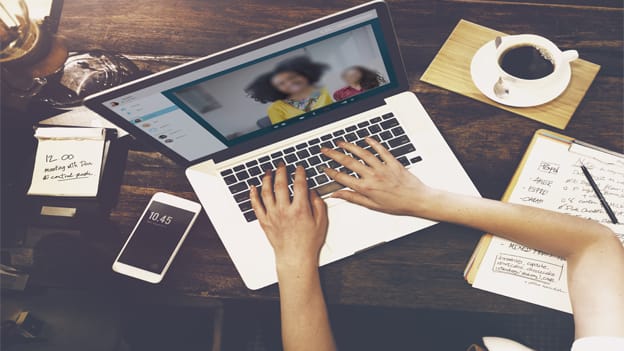Virtual Coffee Breaks: An espresso shot for remote workers

Strolling through the lanes of Cupertino, California; it is likely you will see a massive ‘spaceship’ far away on the ground. As you walk towards the spaceship on the Apple Park Street; after close scrutiny, you will notice that the spaceship is nothing but a giant (175 acres if we are being precise) circular office building. The Apple Park, as the spaceship-like building is famously called, houses 12,000 Apple employees in the confines of its curved glass surface, featuring 8 tall buildings, 9 mini-atria separating the buildings, a courtyard in the middle, a 30-acre park with a pond and fruit trees – all of which are intended to “blur the boundary between nature and building”1. It was a grandeur vision – an extension of the original Apple Campus’ vision of having open spaces to foster a collaborative environment. But this is Apple Park – the new headquarter destination of Apple, and the last art project of Steve Jobs. What about a smaller company with limited resources? How would a small-headcount company with a major proportion of its people working in remote locations foster collaboration and innovation?
Companies are anyway grappling with the issue of disengagement among its employees. Employee engagement has dropped 14 percent in 2017 compared to last year, according to Deloitte’s Human Capital Trends Report 2017, and only 22 percent employees believe that their companies are excellent at creating a differentiated employee experience. The struggle for engaging remote employees is real, with the perceptions of remote workers for their managers and the company worse than the employees who work from the office premises.
A virtual coffee break is a video call that the team members of an organization use to take breaks and socialize
So how can companies engage their remotely-working employees, let alone create an environment where they keep collaborating and innovating? The CEO of GitLab, Sid Sijbrandij, has an answer – A virtual coffee break!
What are Virtual Coffee Breaks?
A virtual coffee break is a video call that the team members at GitLab use to take breaks and socialize, as per the company’s 500-page handbook. “We encourage team members to dedicate a few hours every week to these calls, which is roughly comparable to the time someone working in an office might spend chatting while walking to meetings, grabbing coffee in the break room, or having lunch together in person,” writes the GitLab CEO in his blog for Quartz at Work. A ‘Virtual coffee break’ can be a structured or unstructured break designed for all remote employees to participate in chatter, discussions, even brainstorming. They have to be treated like a water-cooler break, wherein people just gather and chat, about things they want to talk about – last night’s football match, a new film released this week, predictions for the coming elections, or even the office gossip etc.
GitLab is a remote-only company; which means its 200 employees do not come to office – they are scattered across the world in 39 countries.
Visiting their physical office is like going through a maze (or at least the directions given on their ‘Visit Us’ page hints at that), and once one finally manages to cross the maze and enter the office – one is most likely to find Sid Sijbrandij(the CEO) and Suzy (the pet cat) in the room, because everyone else works remotely. For a technology company like GitLab, collaboration is of extreme importance to come up with cohesive products. Also, staying connected is imperative for project teams to develop better. Not to mention the perils of feeling lonely and isolated the remote employees may face if they aren’t involved in social interactions with their peers. GitLab also accompanies designated coffee breaks with a “perpetually open video call” wherein people interested in having a random interaction are paired with each other randomly by a bot they call Donut. They can have a conversation about anything they wish to after being paired randomly with a peer on their #random Slack channel.
What does this mean for you?
Whether ‘Remote only’ or ‘Physical & remote hybrid’ – the concept of virtual coffee breaks (both literally and figuratively) can be of extreme help to organizations to keep their remote employees engaged with the organization-wide activities.
Operationalizing it
Step 1: Find out what employees want
The first step is asking your people what they desire in the remote working environment, what they feel is lacking and needs improvement. Select a small-sized representative sample of people and do an open-ended question-answer session with each one of them individually. Note down their suggestions on things which can be improved. After doing a content analysis and clustering responses, populate a checklist of the most featured sections, and run it through the remotely working population, ranking the areas which need the most improvement. One of the items on the checklist could be lack of interpersonal communication or camaraderie, or working in silos and the feeling of loneliness, for which the virtual coffee breaks can act as a tailor-made solution.
Step 2: Design and start virtual coffee breaks
Introduce virtual coffee breaks to the team. Set a larger window for the duration of the break (possibly an hour), with people having the flexibility to join in the time they feel comfortable to. If the employees are scattered across countries, then two coffee breaks in the day can be a good idea – one in the morning, and one in the evening! Do not make it a stickler for people to attend, policing their participation and converting this into a formal setup. Also have an option where people can backchannel, and everybody should be aware they can backchannel, and so can their colleagues. There has been research which has proven backchannelling to have improved decision-making. One could consider appointing a champion (informally) at the beginning, to break the ice and initiate the conversations!
Step 3: Forum for showing gratitude
Structure some of the virtual coffee breaks in the month where some time is allocated to a gratitude session, wherein people extend gratitude to their peers for the thing they are grateful for their counterpart doing.
Step 4: Balance with other interventions
Like GitLab, combine Virtual Coffee Breaks with open opportunity to video call any randomly selected individual and have a conversation; and also structure some of the meetings where the meeting starts with an individual sharing a story which isn’t a part of their work-life.
If you are a small organization of 100-200 people, do it at organizational level. If you happen to be a mid-sized or large organization, this exercise can be carried at a team-level.
There are some Apple employees who are being sceptical of the Apple Park’s completely open office already. It is not always as straight forward as one envisions; there is always resistance and roadblocks. The organization has to pay heed to those concerns and keep getting better at its practices. As long as they translate it to revenue-related results (Apple is #3 in the Fortune 500 List) and employee satisfaction numbers (GitLab has a 4.9 GlassDoor rating )2, it is worth continuing the efforts towards giving a distinguished experienceto your own people.
Reference:-
*Steve Jobs said in his address to the Cupertino City Council in 2011.
#At the time of writing this article.









